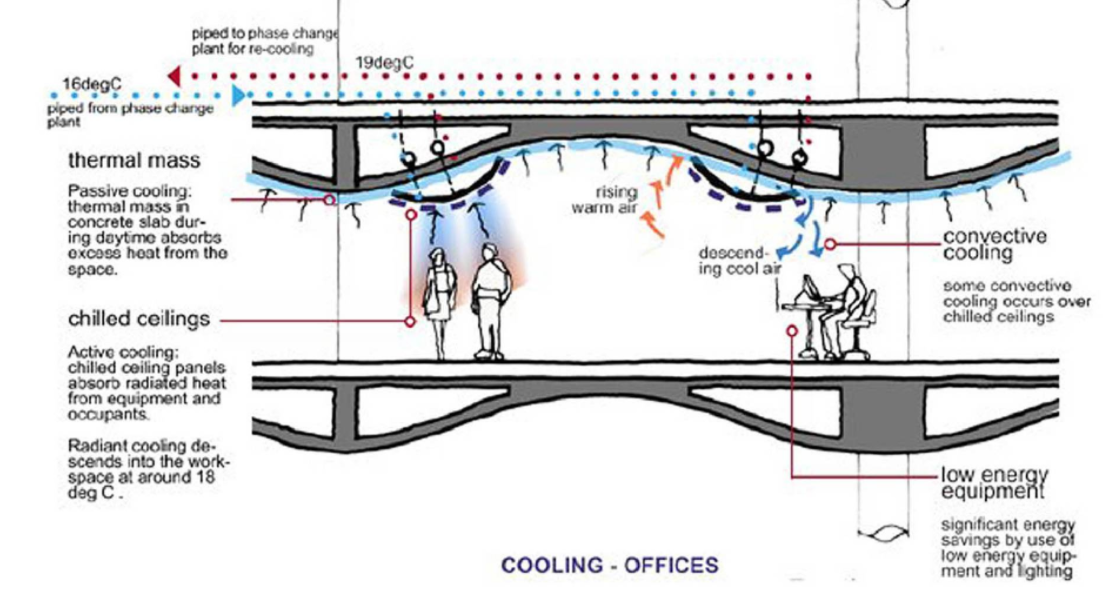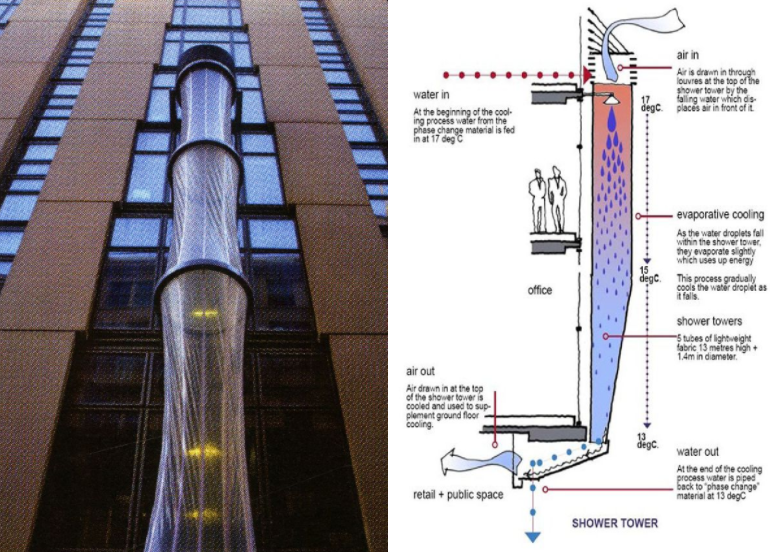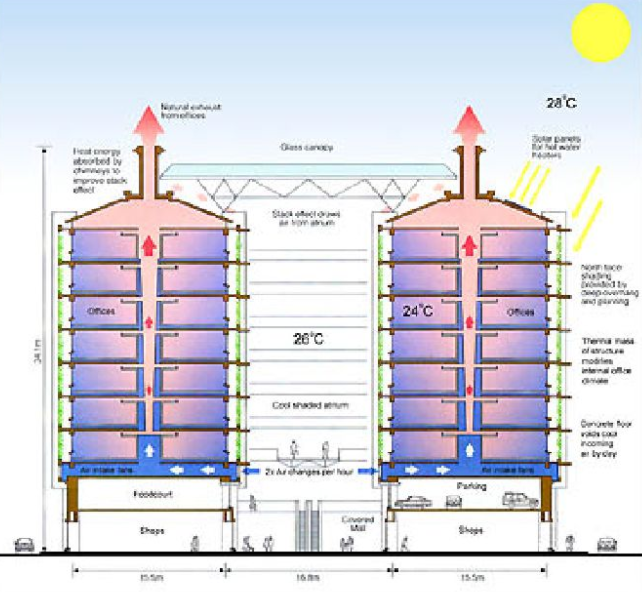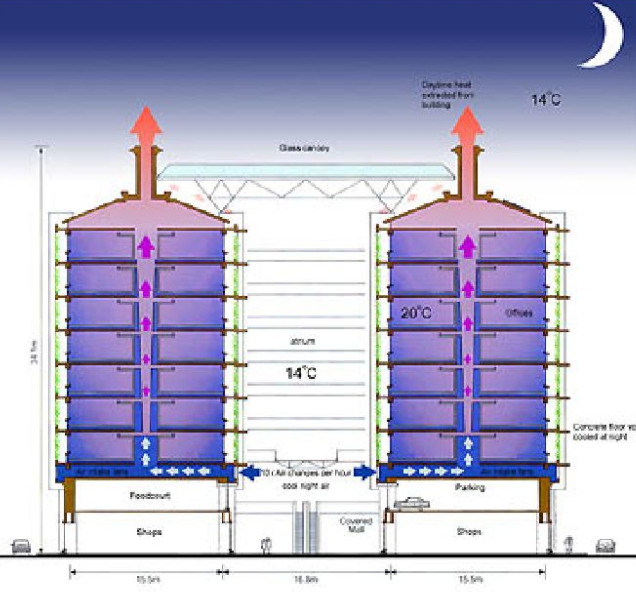Modern buildings and skyscrapers constitute one of the phenomena of large cities that aggressively affect the environment. It goes without saying that cooling is not the primary way to address adverse pressure on the ecological component of the urban environment, yet in conjunction with other measures, it can produce a synergistic effect and optimize the microclimate inside the buildings. This paper focuses on the comparison of cooling strategies utilized in the Council House 2 (CH2) and Eastgate projects, such as shower towers and termitary construction, respectively.
Council House 2 is the first office-type building in Melbourne, Australia that received the prestigious D’STAR Design Award, the Australian equivalent of Leadership in Energy and Environmental Design (LEED) Platinum Certification (Fam, Mitchell, Abeysuriya, & Lopes, 2014). The construction of this famous environmentally-friendly project was completed in 2006, when it was recognized as one of the most secure buildings in the country. The concept behind this building belongs to Rob Adams, the Director of City Design for the city of Melbourne. The team of designers wanted the energy- and water-saving project to meet the climatic and environmental conditions of this Australian city.
The architect of the project, Mick Pearce, filled the interior space with natural light so that there would be no need to use artificial lighting in the daytime. Due to the north and south glass façade that absorb heat from a curved concrete floor, ventilation shafts with extended upper sections, and the use of so-called light shelves, an architectural element contributing to the penetration of natural light deep into the rooms, the building receives a maximum of fresh air and natural light while maintaining a constant temperature (“Council House 2 Melbourne,” 2016).
Concrete floors and interior surfaces, which are cooled at night by open windows, provide an effective system of passive cooling. Windows that open at night also provide the building with fresh air, while the temperature and humidity levels of the air are constantly monitored (Fam et al., 2014). The air conditioning system automatically responds to sudden and frequent changes in temperature. In the basement of the building, there are three cisterns that deliver chilled water to the ceiling panels. As an additional component of the system, air is cooled in a special tower and then transferred to the shops and offices (Image 1).

Another key feature of the design of the cooling system is that the lamellas made of processed wood on the western part of the building protect the premises from the sun during the day, while at night they remain open, which makes it possible to fill the interior with fresh air. As in most such projects, the CH2 kinetic façade is part of a system that includes the collection of rainwater, wind turbines, water heating using solar energy, and photovoltaics (Sharma, Tjandraatmadja, Cook, & Gardner, 2013). It is constructed of “shower towers” attached to the façade with the help of staples (Image 2).

As a rule, plants grow from special modules located along the entire height of the wall. A set of measures for greening buildings minimizes the negative impact of a high-rise building on the environment. For instance, within the framework of the CH2 project, one of the significant innovative technological solutions was the partial use of vertical landscaping, so-called green walls. In addition, especially in countries with hot climates, the façade system of gardening positively affects the energy consumption levels, as it increases thermal insulation and reduces heat loss through the enclosing structures (Sharma et al., 2013).
Working like solar shaders, it provides sun protection and cooling by evaporating moisture and reducing wind speed. Shading from plants reduces the temperature gradient on the inner and outer surfaces of the enclosing structures. Consequently, the thermal conductivity of the structures and the infiltration of air into the premises are reduced, which decreases the building’s consumption of electricity.
For its part, the Eastgate Center in Harare, Zimbabwe represents one of the best examples of green architecture and sensitive environmental adaptations. The Eastgate Center is the country’s largest office and shopping center, and a building in which the principles of biomimetic knowledge were utilized (Dahl, 2013). This average height building designed by the architect Mick Pearce in collaboration with Arup Associates has no traditional air conditioning or cooling systems.
Nevertheless, it remains adaptable to climate conditions all year round while consuming an astonishingly small amount of energy. The design method used for it was inspired by the self-cooling embankments of African termites that are heated and cooled only by natural air flows (Hunter, 2014). For example, the reduction in distance between floors used as air ducts is achieved through an additional floor increase.
Mick Pearce noticed that termites construct their dwellings in a special way so that the temperature inside is always 30.5 degrees Celsius. The insects have come up with an unusual system of ventilation flaps that constantly open and close to maintain the temperature (Dahl, 2013).
The Eastgate Center in Harare is based on similar principles. The passive cooling system of the Eastgate building costs a tenth as much as conventional cooling systems. It works by absorbing heat in the walls of the building during the day, and at night with the help of fans pumping the heat back into the room (Image 3 and 4). At the same time, Eastgate uses 35 percent less energy than similar buildings in Harare (“Eastgate,” 2016).


This building is principally constructed of concrete, and there is a ventilation system that works in a similar way. The external air entering the building either heats up or cools, depending on what is warmer at the time – the temperature of the air, or the concrete of the building. Then the air exits through the exhaust pipe upward, ventilating the floors of the building and offices. In addition, the complex consists of two buildings located side by side. They are separated from each other by open space that is covered with glass and thus does not interfere with the movement of local breezes (Hunter, 2014).
Air is constantly taken from this open space to the first floor with the help of special fans. After that, the air moves upstairs and supplies air ducts that are placed in the central parts of both buildings. Fresh air replaces the old, which rises and leaves through holes in the floors of each storey. Eventually, the air enters the vertical exhaust pipe and exits the building through chimneys.
To conclude, it must be emphasized that both CH2 and Eastgate use quite successful cooling systems based on passive cooling. While CH2 uses shower towers that ensure proper cooling by night and day, Eastgate is designed according to the construction of termitaries. Both of these methods are environmentally friendly and cost-effective compared to traditional building methods.
References
Council House 2 Melbourne. (2016). Web.
Dahl, R. (2013). Cooling concepts: Alternatives to air conditioning for a warm world. Environmental Health Perspectives, 121(1), 18-25.
Eastgate. (2016). Web.
Fam, D., Mitchell, C., Abeysuriya, K., & Lopes, A. M. (2014). Emergence of decentralised water and sanitation systems in Melbourne, Australia. International Journal of Water, 8(2), 149-165.
Hunter, P. (2014). Turning nature’s inspiration into a production line: Exploits of natural designs have become a systematic research field to create new materials and designs for architecture, medicinal devices and other products. EMBO Reports, 15(11), 1123-1127.
Sharma, A. K., Tjandraatmadja, G., Cook, S., & Gardner, T. (2013). Decentralised systems–definition and drivers in the current context. Water Science and Technology, 67(9), 2091-2101.